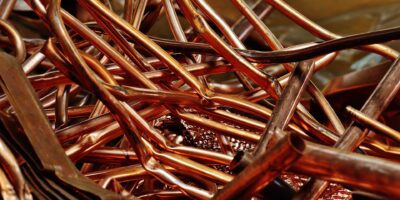
By Hubble Space Telescope –Wikipedia
Top 10 Facts about Neptune
Neptune was discovered in 1846 by Johann Galle and Heinrich d’Arrest. It is, however, named after the Roman god of the sea. It was the first planet to be discovered using mathematics, rather than observational evidence.
However, here are some of the top 10 facts about Neptune that you should consider learning;
1. It is one of the smallest gas giants
Neptune is the smallest of the gas giants and is also the farthest from the Sun. One reason Neptune is the smallest of the gas giants may be because it formed farther from the Sun than the other planets in this category. It is also possible that Neptune lost some mass over time due to its interaction with the Sun’s gravity.
Despite being the smallest of the gas giants, Neptune is still a large and fascinating planet. It has an interesting system of rings and moons and is home to some of the most extreme weather conditions in the solar system.
2. It has the strongest winds in the solar system
Neptune’s winds are thought to be caused by the planet’s fast rotation and strong internal heat. The winds blow in a west-to-east direction and are strongest at the equator. The winds help to drive Neptune’s large and bright atmospheric features, such as the Great Dark Spot and the Bright Spot.
The winds on Neptune are thought to be the strongest in the solar system because of the planet’s fast rotation and strong internal heat. The winds blow in a west-to-east direction and are strongest at the equator. The winds help to drive Neptune’s large and bright atmospheric features, such as the Great Dark Spot and the Bright Spot.
3. The planet has the largest and most violent storms in the solar system

By NASA/Voyager 2 Team –Wikipedia
Neptune’s atmosphere is very turbulent, and the Great Dark Spot is a large storm system that can span up to 10,000 kilometers. These storms can last for months or even years and can be very violent, with winds reaching up to 2000 kilometers per hour.
The Great Dark Spot is not the only storm system on Neptune, but it is the largest and most well-known. Other storm systems on Neptune include the Small Dark Spot, which is about half the size of the Great Dark Spot, and the Bright Storm, which is a smaller and less violent storm.
4. It has 14 moons, the largest being Triton

By NASA’s James Webb Space Telescope – Wikipe,,dia
Neptune has 14 moons. Triton is however, the largest moon, measuring 2,700 kilometers in diameter. It is the only large moon in the solar system with a retrograde orbit, meaning that it orbits Neptune in the opposite direction to the planet’s rotation.
The other moons of Neptune are much smaller, ranging in size from Nereid (340 kilometers in diameter) down to the very small moons Despina (170 kilometers) and Naiad (50 kilometers). These moons all have prograde orbits, meaning that they orbit Neptune in the same direction as the planet’s rotation.
5.Neptune has a faint ring system composed of dust particles
Neptune’s rings are composed of dust particles, which are thought to be debris from comets and asteroids that have broken up in Neptune’s orbit. The rings are very faint and difficult to observe.
There are four main rings: the innermost ring, the Galle ring; the middle ring, the Le Verrier ring; the outer ring, the Adams ring; and the outermost ring, the Arago ring. There is also a faint fifth ring, called the Lassell ring, which is located between the Le Verrier ring and the Adams ring.
6.Neptune is the farthest planet from the sun
Neptune has an equatorial diameter of 49,532 kilometers, making it about four times the size of Earth. Neptune is so large that it could fit more than 60 piles of earth inside of it. Neptune has a mass of 1.02 x 10^26 kg, about 17 times the mass of Earth. Neptune is made up of a rocky core surrounded by a mantle of water, ammonia, and methane. The atmosphere of Neptune is made up of hydrogen, helium, and methane.
7. Neptune has the longest day of any planet in the solar system
Neptune’s day is almost 16 hours long, which is the longest day of any planet in the solar system. This is because Neptune’s rotational period is the slowest of all the planets.
Neptune is also the coldest planet in the solar system and has the strongest winds. These winds can reach speeds of up to 2,100 kilometers per hour.
8. Neptune has the shortest year of any planet in the solar system

By NASA (image modified by Jcpag2012) and NASA / JPL / Voyager-ISS / Justin Cowart – Wikipedia
Neptune has the shortest year of any planet in the solar system, lasting 164.8 years. This is because Neptune is the farthest planet from the sun, and it takes longer for it to orbit the sun than any other planet.
9. Neptune is sometimes referred to as the “windy planet”
Neptune is sometimes referred to as the “windy planet” due to the high winds in its atmosphere. These winds can blow at up to 1,500 kilometers per hour, making them some of the fastest winds in the solar system. The winds are thought to be caused by the planet’s low temperature, which causes the atmosphere to be very dense.
The high winds on Neptune can make it a difficult place for spacecraft to land. The only spacecraft to successfully land on Neptune was the Soviet Union’s Vega 2, which landed on the planet’s largest moon, Triton, in 1989.
10. Neptune is the second densest planet in the solar system, after Uranus

By Looking many thanks to the author of the original simulation = Wikipedia
Neptune’s high density can be explained by the fact that it is composed of a large number of ices, such as water, methane, and ammonia. The ices make up about 60-70% of Neptune’s mass.
Neptune’s large mass and high density imply that it has a very large gravity. This is why Neptune has such a large and deep atmosphere. The pressure at the surface of Neptune is about 2.5 times that of Earth’s atmosphere.
Planning a trip to Paris ? Get ready !
These are Amazon’s best-selling travel products that you may need for coming to Paris.
Bookstore
- The best travel book : Rick Steves – Paris 2023 – Learn more here
- Fodor’s Paris 2024 – Learn more here
Travel Gear
- Venture Pal Lightweight Backpack – Learn more here
- Samsonite Winfield 2 28″ Luggage – Learn more here
- Swig Savvy’s Stainless Steel Insulated Water Bottle – Learn more here
Check Amazon’s best-seller list for the most popular travel accessories. We sometimes read this list just to find out what new travel products people are buying.









